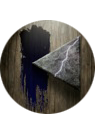What is a paper mock? We are high tech geeks – we don’t need no stinking paper!
In my mind, “paper” is more about a state of mind than it is about media. The goal of a paper mock is to be highly collaborative, non-attached, and open.
Typical ‘designers’ (not Design Thinkers) sit in a room by themselves and create “amazing” ideas! More often than not this leads to:
- Ideas devoid of feedback, group input, and shared joy that comes from discovering ideas with others.
- Many hours spent thinking hard; thus generating an ego attachment that grows stronger with more toil.
- Ideas with crystal clarity for one person generates a hesitation to open sharing – “After all they might not share my clarity!! How frustrating.”
A Design Thinking team starts with paper mocks – often literally paper. They want to have something they can all see. Also, they all tend to have about equal skills for updating and modifying. This setup also allows for a fun collegial environment where the team gets great ideas and is pumped to deliver them.
Quickly generating ideas as a group molds the ideas to a broader appeal in a fun way. A successful product demands that it appeals to thousands or ideally millions of minds, so you might as well start with a few minds as you build instead of waiting!
What are the steps? Well, you can start with paper. It is handy to have some dice, little wooden tokens, clay, pens, cards, any old thing you might be able to improvise with. (A scanner/printer or copier can be great as in: “Oh cool hex! It would be great to have 20 of them!”)
If you are looking to build an app you should think in terms of screens and screen flow. Slapping it on index cards with some names of the screens allow you to reference them from ‘buttons’ that are drawn on the screens. Then you can perform a simple play test by handing your ‘home screen’ from the deck to someone on the street. As they push ‘buttons’ you switch cards with them. I have even seen groups where their first cut UI in an app are cell phone photos of their cards with touch detection added. For an example, check out the POP (Prototyping on Paper) app. However, if you looking to only build a tabletop game then re-drawing more neatly on thicker paper maybe all that is required!
If you were really going to make a commercial product, then I would recommend taking the “paper” version one step further with a wireframe tool like Balsamiq. It is easier to get a team on the same page when your mock can have review commentary ‘post-its’ added. Then you can revision it in an artifact management tool (GIT, SVN, whatever…) A more formal tool like Balsamiq does still have a ‘run-mode’ that allows you to hide the commentary and have live buttons that switch screens. Balsamiq even has an export mode where you can export a ‘runnable’ mock that uses a PDF format with active links. Here the ‘buttons’ are doc links that take you to new pages of the PDF.
The key point to not lose: it should about having fun! Keep it simple. Keep it open. The more minds the merrier. The more minds that like it as they are building it, the better chance there is that more minds will like it when it ships!

